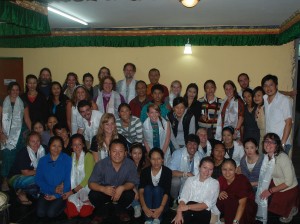 The Burmese folk gathered at the bus station, festooned with khatas presented by TWA and SFT, basking in handshakes, hugs, tears and wide smiles from friends, and I felt in my heart that something very special had happened in these last few days.
The Burmese folk gathered at the bus station, festooned with khatas presented by TWA and SFT, basking in handshakes, hugs, tears and wide smiles from friends, and I felt in my heart that something very special had happened in these last few days.
This was the third annual visit by Burmese refugees from Delhi to Dharamsala.
Arrival day had been very welcoming. The visitors toured the Library, entered the Tibetan Parliament in session (to welcoming, supportive words and a round of applause of solidarity for Aung San Suu Kyi and Burma), met MP’s, the LTWA Translation Class, journalists and activists, Heads of Government Departments, and finally with the Kalon Tripa.
At least four of the visitors were ex-political prisoners, ‘Freedom Fighters’ with extraordinary human rights stories, some known internationally. Among them were activists, students, teachers, NGO workers, advocates at Burma Centre Delhi, a thoughtful visionary monk, and articulate, intelligent Dr Alana, a Naga-Indian companion. All were from different ethnic groups and religious beliefs. Many here seemed to know who the visitors were, and there was a lot of curiosity, and a strong feeling of welcome, which they all felt. Even when we all filed into His Holiness’ area, for an unexpected audience, there were many people in the Temple sending encouraging smiles.Waiting in his garden for His Holiness to arrive was a heady experience for everyone, and there was lots of joking and rather deep discussion about Burma, the conditions there, recent events, and 2200 political prisoners.
Special guide Tenzin Tsundue gave lots of savvy advice from experience, especially advising everyone to ‘laugh at’ their enemy, and ignore the guns, even when standing beside them, ‘as Tibetans have learned to do’! Somehow I think Aung San Suu Kyi would have been delighted!
Despite the intensity of the previous hours at the special Religious Conference, His Holiness welcomed everyone with comforting, supportive and uplifting words about Burma and Aung San Suu Kyi, spoken with gravity into our eyes. We all floated away, and tried to remember what he had actually said. ‘We are all one… we are all freedom fighters… non-violence… self-confidence…be committed…approach must be realistic…we have just started… following a non-violent approach…it will not be easy.’
Later, visiting NGO’s, much was taught and lessons were learned from experience passed on. There were secret and not so secret tears, the support was tangible, and sharing of Tibetan strength and ideas and advice very useful. After rest, chats, and chai in the street, perched on the steps of the Peace Cafe, everyone headed off to the film screening.
The film was a recent report of the history, conditions and situation of the tortured ethnic Karen, by an Australian journalist at Mae Sot. Landmines and jungle warfare add to the people’s pain, and it was lovely to hear Dr Cynthia Maung’s softly spoken words at her essential support clinic in Thailand. Hardened rebels cried. Burmese people just want peace!
Many in the audience were engaged and deeply moved, and came up afterwards to ask how they could assist, or just to connect. Some came to the dinner. Slowly the stories came out.
At Norbulingka the next day, everyone was in awe of the cultural beauty the Tibetans have preserved, created, and showcased there with the help of the world. Burma’s richness has been severely plundered, and the people are now the poorest in SE Asia. We discussed the hated Chinese dams in Burma, and water, beside the flowing sounds in the gardens.
The Gyuto monks turned it on for us after our tour behind His Eminence, the Karmapa’s house, garden and the silent meditation houses, with a beautiful monastery lunch.
Ven monk U Agga commented that it was like a dream, this beautiful monastery with the mountains behind it. The Burmese girls served him food, and we saw again a cultural difference: the group had never seen classes before with monks and laypeople studying together, like in the Library. Temple sounds rang out, and everyone quietly ascended and peeked in, at the formal rows of chanting monks.
The importance of education in Tibetan life clearly touched everyone, whether at TCV school, monasteries, and even just sitting in dreamed-of classrooms. Education and health in Burma is very poor, as billions of dollars are funnelled off to overseas banks from gem sales, oil gas and other resources sold to neighbours, and national and private assets are seized and sold. There is a great deal of suffering.
After a free afternoon, our tired friends spoke quietly and openly about what they had discovered, learned, and experienced. I felt a real wrench when they left, as always feeling their pain and softness, and the extraordinary national hardship, often out of most people’s minds due to the ‘secret’ nature of their oppression. I was so glad they had come.
Overall, it was clear that the extraordinary achievements made by the Tibetans over 50 years since the terrible early days has been inspiring and supportive and uplifting to the visitors. Touched, their beautiful smiles came out, like sun after rain. Tibetan strength and generosity (and most of all experience) has been helpful.
Many people collaborated to achieve and organise this visit: A Tibetan-Burmese Friendship fundraising night in Sydney, Jigdal and dedicated friends from SFT, Tenzin Tsundue, (‘They don’t need water, they are activists!’) TWA, Gu Chu Sum and TYC… It was all worth the effort. His Holiness, the Parliament, Tibet, Australia, and many kind people, standing together, were saying to these traumatized, lovely visitors: ‘We Care’.




 Print
Print Email
Email